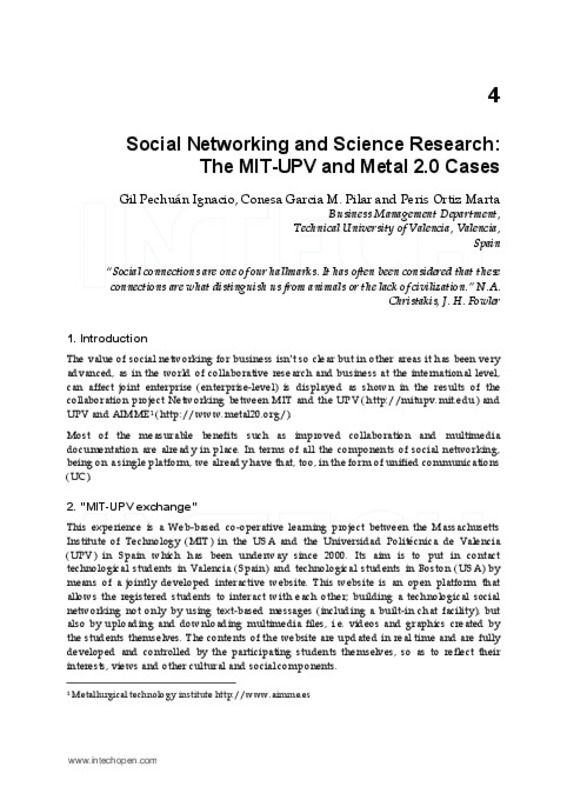JavaScript is disabled for your browser. Some features of this site may not work without it.
Buscar en RiuNet
Listar
Mi cuenta
Estadísticas
Ayuda RiuNet
Admin. UPV
Social Networking and Science Research. The MIT-UPV and Metal 2.0 Cases
Mostrar el registro sencillo del ítem
Ficheros en el ítem
| dc.contributor.author | Gil Pechuán, Ignacio
|
es_ES |
| dc.contributor.author | Conesa García, María Pilar
|
es_ES |
| dc.contributor.author | Peris-Ortiz, Marta
|
es_ES |
| dc.contributor.editor | Deb, Sagarmay
|
es_ES |
| dc.date.accessioned | 2014-04-15T07:25:58Z | |
| dc.date.available | 2014-04-15T07:25:58Z | |
| dc.date.issued | 2012 | |
| dc.identifier.isbn | 978-953-51-0078-2 | |
| dc.identifier.uri | http://hdl.handle.net/10251/37030 | |
| dc.description.abstract | The value of social networking for business isn't so clear but in other areas it has been very advanced, as in the world of collaborative research and business at the international level, can affect joint enterprise (enterprise-level) is displayed as shown in the results of the collaboration project Networking between MIT and the UPV (http://mitupv.mit.edu) and UPV and AIMME1 (http://www.metal20.org/). Most of the measurable benefits such as improved collaboration and multimedia documentation are already in place. In terms of all the components of social networking, being on a single platform, we already have that, too, in the form of unified communications (UC). Many experts conclude that the crowdsourcing can be applied to a wide variety of problems, and that it raises numerous interesting technical and social challenges. Given the success of current CS systems, they expect that this emerging field will grow rapidly. In the near future, they foresee three major directions: more generic platforms, more applications and structure, and more users and complex contributions. The networks have a life. They grow, change, reproduce, survive and die. A social network is a kind of super human, with an anatomy and physiology of their own. Social networks can develop a type of intelligence that increases or supplements individual intelligence. | es_ES |
| dc.language | Inglés | es_ES |
| dc.publisher | InTech | es_ES |
| dc.relation.ispartof | Advanced Topics in Multimedia Research | es_ES |
| dc.rights | Reconocimiento (by) | es_ES |
| dc.subject | Social networking | es_ES |
| dc.subject | Business | es_ES |
| dc.subject | Collaboration project Networking between MIT and the UPV | es_ES |
| dc.subject | Crowdsourcing | es_ES |
| dc.subject.classification | ORGANIZACION DE EMPRESAS | es_ES |
| dc.title | Social Networking and Science Research. The MIT-UPV and Metal 2.0 Cases | es_ES |
| dc.type | Capítulo de libro | es_ES |
| dc.identifier.doi | 10.5772/36052 | |
| dc.rights.accessRights | Abierto | es_ES |
| dc.contributor.affiliation | Universitat Politècnica de València. Departamento de Organización de Empresas - Departament d'Organització d'Empreses | es_ES |
| dc.description.bibliographicCitation | Gil Pechuán, I.; Conesa García, MP.; Peris-Ortiz, M. (2012). Social Networking and Science Research. The MIT-UPV and Metal 2.0 Cases. En Advanced Topics in Multimedia Research. InTech. 53-64. doi:10.5772/36052 | es_ES |
| dc.description.accrualMethod | S | es_ES |
| dc.relation.publisherversion | http://dx.doi.org/10.5772/36052 | es_ES |
| dc.description.upvformatpinicio | 53 | es_ES |
| dc.description.upvformatpfin | 64 | es_ES |
| dc.relation.senia | 236626 |








